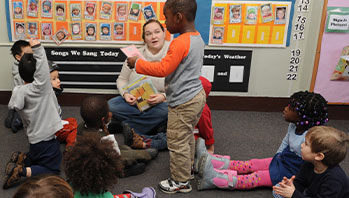- chart paper
- marker
MA Standards:
English Language Arts/Speaking and Listening/SL.PK.MA.1a: Observe and use appropriate ways of interacting in a group (e.g., taking turns in talking, listening to peers, waiting to speak until another person is finished talking, asking questions and waiting for an answer, gaining the floor in appropriate ways).
English Language Arts/Foundational Skills/RF.PK.MA.2: With guidance and support, demonstrate understanding of spoken words, syllables, and sounds (phonemes).
Head Start Outcomes:
Social Emotional Development/Self-Regulation: Follows simple rules, routines, and directions.
Language Development/Receptive Language: Attends to language during conversations, songs, stories, or other learning experiences.
Literacy Knowledge/Phonological Awareness: Identifies and discriminates between separate syllables in words.
PreK Learning Guidelines:
English Language Arts/Language 1: Observe and use appropriate ways of interacting in a group (taking turns in talking; listening to peers; waiting until someone is finished; asking questions and waiting for an answer; gaining the floor in appropriate ways).
English Language Arts/Reading and Literature 12: Listen to, recite, sing, and dramatize a variety of age-appropriate literature.
English Language Arts/Reading and Literature 8: Listen to, identify, and manipulate language sounds to develop auditory discrimination and phonemic awareness.
Mathematics/Number Sense 3: Use positional language and ordinal numbers (first, second, third) in everyday activities.
Word Play: Segment Sentences, #2

© Commonwealth of Massachusetts, Department of Early Education and Care (Jennifer Waddell photographer). All rights reserved.
ELA Focus Skills: Math, Phonological Awareness, Speaking and Listening, Word Recognition
Help children practice segmenting the words in a sentence. On chart paper, write the sentence “There were ten on the sled,” speaking the words aloud as you write.
- Have children listen carefully as you read this sentence from the book Ten on the Sled: “There were ten on the sled.” Track the words as you read.
- Explain that the sentence is made up of words. Ask children how many words are in my sentence. Say, Listen as I read the sentence and clap each word. Say each word slowly and clap.
- Ask children how many times did I clap? Say, There are six words in the sentence. Say the sentence with me and clap the words. Repeat the sentence, tapping on each word as children clap.
- Write a number, in order, under each word: 1-2-3-4-5-6. Say, Who can tell me the fourth word in the sentence? What is the first word in the sentence?
Take It Further: Have children find sentences on charts in the room or in favorite books, help them to read the sentences aloud, count the number of words in the sentences, and then identify various words within the sentences.
Adaptation: In groups with varying ages, challenge older children. Write the words to the sentence “There were ten on the sled” on small word strips. Insert the strips in a sentence chart, reading them aloud as you do. Have a duplicate set of word cards in a line on a table, out of order. Read the words aloud. Guide children to understand that the words do not make sense out of order. Ask children to put the words in the correct order to match the original sentence. Then read the sentence together and talk about how it now makes sense.
English Language Learners: Say each ordinal number while pointing to the numeral. Have children point and repeat after you.
